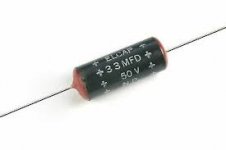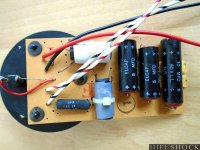Apologies for the noobish question. Being a noob it's all I have.
I'm wanting to wire four 8 ohm speakers (MS Festival 2) i.e. two on each channel, to my amp (Trio KA-3700). Obviously seeing as 1/(1/8 + 1/8) = 4, which is technically within the impedance limits of the amp (4-16 ohm), this should be fine in theory. However, I'm concerned that, for example, small inaccuracies in the manufacture of the speaker circuitry or environmental changes could bring the actual impedance below the theoretical value. Obviously this is unlikely to be a serious deviation but it could possibly bring it below the 4 ohm minimum which puts the amp at risk.
Is this a legitimate fear? Should I be considering adding a 1 ohm power resistor to each speaker to produce >4 ohms?
N.B. I currently have the speakers wired in series and it's all a little toothless as a result.
I have looked for similar questions, but I've not found anything precise. I do apologise if this is an FAQ that everyone is bored of answering!
Many thanks in advance.
I'm wanting to wire four 8 ohm speakers (MS Festival 2) i.e. two on each channel, to my amp (Trio KA-3700). Obviously seeing as 1/(1/8 + 1/8) = 4, which is technically within the impedance limits of the amp (4-16 ohm), this should be fine in theory. However, I'm concerned that, for example, small inaccuracies in the manufacture of the speaker circuitry or environmental changes could bring the actual impedance below the theoretical value. Obviously this is unlikely to be a serious deviation but it could possibly bring it below the 4 ohm minimum which puts the amp at risk.
Is this a legitimate fear? Should I be considering adding a 1 ohm power resistor to each speaker to produce >4 ohms?
N.B. I currently have the speakers wired in series and it's all a little toothless as a result.
I have looked for similar questions, but I've not found anything precise. I do apologise if this is an FAQ that everyone is bored of answering!
Many thanks in advance.
It is a reasonable concern, but it is likely to be OK. Listen for distortions at normal levels to see whether this is a good idea. Listen for distortions as you go near the upper end of the volume level. You might detect a slight burning smell from the amp as you take it beyond its usual limits.
Thanks for the speedy reply! I have to say that "look out for a burning smell" does instil a degree of fear 😂.
I rarely push the system up to full volume (I have small children and play music almost exclusively at night), so I'm hoping that keeping away from full power should hopefully avoid burning smells, but I will look out for the distortions.
Can I ask: what would be the mechanism by which distortions would be generated if there was an issue?
Many thanks
I rarely push the system up to full volume (I have small children and play music almost exclusively at night), so I'm hoping that keeping away from full power should hopefully avoid burning smells, but I will look out for the distortions.
Can I ask: what would be the mechanism by which distortions would be generated if there was an issue?
Many thanks
It's connected with the demand for more current. You may notice it is not as pleasant. It's not the same as the usual signal getting so large that the Voltage hits the rails and you can tell it's at the limit. Just listen for any signs of strain.
Don't be alarmed a the smell thing, your nose is supposed to be a finely tuned tool when it comes to electronics.
Don't be alarmed a the smell thing, your nose is supposed to be a finely tuned tool when it comes to electronics.
Quite so - it alerted my last time I fried my amp after an extremely dodgy speaker wiring job. Thankfully just a pair of blown fuses last time!
Thanks for your advice, it's greatly appreciated.
Thanks for your advice, it's greatly appreciated.
Some more 'noob' information for good measure:
8 ohm is the nominal impedance of one of your MS speakers.
The actual impedance varies with frequency and will actually exceed 8 ohm over a range of frequencies.
On that basis, I agree with AllenB that parallel wiring two of your MS speakers should be OK.
What I really want to add to the discussion is that you should not contemplate adding a 1 ohm resistor to each MS speaker. This would waste power by converting electrical energy into heat, and may alter the sound of the speaker.
8 ohm is the nominal impedance of one of your MS speakers.
The actual impedance varies with frequency and will actually exceed 8 ohm over a range of frequencies.
On that basis, I agree with AllenB that parallel wiring two of your MS speakers should be OK.
What I really want to add to the discussion is that you should not contemplate adding a 1 ohm resistor to each MS speaker. This would waste power by converting electrical energy into heat, and may alter the sound of the speaker.
Thank you for that - yes, I was certainly aware that impedance is variable dependent on frequency, but wasn't really sure how this translated into into the hifi world. Is there a benchmark frequency at which impedances are generally stated? I assume there must (may?) be, otherwise giving an impedance range for an amp would be somewhat meaningless if another frequency was being stated for the speakers?!
Yes, throwing away signal is definitely bad, as long as keeping it doesn't fry anything 🙂
Many thanks!
Yes, throwing away signal is definitely bad, as long as keeping it doesn't fry anything 🙂
Many thanks!
As a rule of thumb only: The actual impedance is equal to the stated impedance somewhere between where the impedance peaks at the frequency of resonance of the bass driver and where it peaks again at the crossover frequency - say 400Hz.
Last edited:
OK so there's not a consistent frequency used between devices, manufacturers, models etc, for the reason that crossover frequencies and bass driver resonant frequencies are not consistent.
Half of my brain now wants to start measuring impedance at various frequencies. The other half wants to say "ah, just plug 'em in and keep your nose peeled for funny smells"!
Thanks Galu, given me plenty to think about there.
Half of my brain now wants to start measuring impedance at various frequencies. The other half wants to say "ah, just plug 'em in and keep your nose peeled for funny smells"!
Thanks Galu, given me plenty to think about there.
Another thing worth noting is that your vintage Festival 2 bass drivers were made in the days before manufacturers started to put 4 ohm bass drivers into their speakers to improve sensitivity, but called the speaker 8 ohm compatible.
Your DSB 208 bass drivers are likely to be 'real' 8 ohm nominal unlike those of many modern speakers.
If you have access to a multimeter, you could measure the DC resistance of the bass driver. Add a third of the measured value on to the reading and you have a good indication of the true nominal impedance of the bass driver, which may set your mind at rest.
Your DSB 208 bass drivers are likely to be 'real' 8 ohm nominal unlike those of many modern speakers.
If you have access to a multimeter, you could measure the DC resistance of the bass driver. Add a third of the measured value on to the reading and you have a good indication of the true nominal impedance of the bass driver, which may set your mind at rest.
Here's another thing to think about. 😀Thanks Galu, given me plenty to think about there.
ELCAP bipolar electrolytic capacitors were fitted in the Festival 2 crossovers and I wonder if you've replaced them?
Those particular capacitors deteriorate with age and you may improve the sound of your Festivals by replacing them with modern bipolar electrolytics.
If you want more details, just ask.
Attachments
The cap is definitely on the way out on the one speaker, though I can't see the rest being far behind. Can I just use a generic cap or do I need to be looking at a specific component? My assumption was that as long as the capacitance is right it should be fine?
Thanks for the info 🙂
Thanks for the info 🙂
"The cap"? - Is there just a single cap on the tweeter in your Festival 2s and not a full crossover network on a board?
Replacement bipolar electrolytics like these from Wilmslow Audio are what you are after:
Mundorf Electrolytic ECap Capacitors
P.S. It's not just the capacitance value that can change over time, but also the equivalent series resistance, or ESR.
Replacement bipolar electrolytics like these from Wilmslow Audio are what you are after:
Mundorf Electrolytic ECap Capacitors
P.S. It's not just the capacitance value that can change over time, but also the equivalent series resistance, or ESR.
Not sure yet, haven't opened them up. I refer you back to my original point about being a noob. My previous (until your last comment) assumption was that there was just a simple high pass filter made from a capacitor and a resistor. I'm beginning to suspect things are more complicated.... ��
OK great, thank you, I will do.
I should probably go and learn a little about what they're actually doing, too!
Replacing the 5uFs with 4.7uFs should have a negligible effect on the impedance, right?
Thanks for your patience in the face of questions I should really already know the answer to...
I should probably go and learn a little about what they're actually doing, too!
Replacing the 5uFs with 4.7uFs should have a negligible effect on the impedance, right?
Thanks for your patience in the face of questions I should really already know the answer to...
Glad to help keep those vintage Mordaunt Shorts going.
The difference between 4.7uF and 5uF is negligible in this context - the ELCAPS are unlikely to have been exactly 5uF originally anyway.
The difference between 4.7uF and 5uF is negligible in this context - the ELCAPS are unlikely to have been exactly 5uF originally anyway.
Great - just put an order in for those capacitors from Wilmslow, as per your recommendation. Looking forward to getting the soldering iron out now!
Well thank you so much for the help Galu. I have now fitted the replacement capacitors and also discovered a tweeter was blown, so I rewound its voice coil whilst I had it all open. That was fun..... thankfully a tweeter voice coil is fairly bulky compared to the coils I've wound before so it wasn't too painful.
Anyway, the Mordaunt Shorts now sound terrific. There is a slight difference between the original coils and the new one, but it's very minor and with the cap replacement I couldn't be happier. Many thanks everyone for the advice!
Anyway, the Mordaunt Shorts now sound terrific. There is a slight difference between the original coils and the new one, but it's very minor and with the cap replacement I couldn't be happier. Many thanks everyone for the advice!
- Home
- Loudspeakers
- Multi-Way
- Noob parallel wiring and impedance limits

